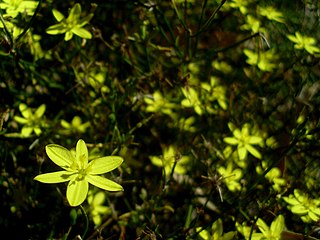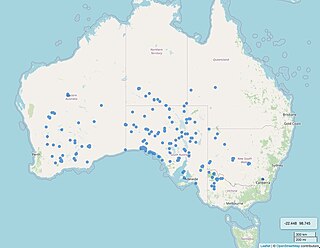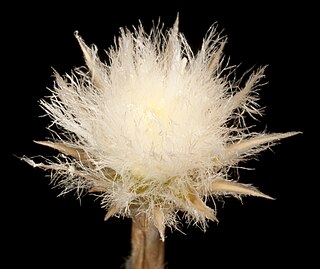
Darwinia, sometimes commonly known as mountain bells or simply bells, is a genus of about 70 species of evergreen shrubs in the family Myrtaceae, endemic to southeastern and southwestern Australia. The majority are native to southern Western Australia, but a few species occur in South Australia, New South Wales and Victoria. The genus was named in honour of Erasmus Darwin, grandfather of Charles Darwin by Edward Rudge in 1816. Most darwinias grow to a height of between 0.2 and 3 m, and many are prostrate shrubs. Most have small, simple leaves and the flowers are often grouped together, each flower with five red, white or greenish petals and ten stamens. In many species, the flowers are surrounded by large, colourful bracts, giving rise to their common names.

Petrophile is a genus of evergreen shrubs, in the family Proteaceae. The genus is endemic to Australia. Commonly known as conebushes, they typically have prickly, divided foliage and produce prominently-displayed pink, yellow or cream flowers followed by grey, conical fruits.

Trachymene is a genus of herbaceous plants in the family Araliaceae. The species are native to Australia, Malesia, New Caledonia and Fiji.

Calytrix is a genus of shrubs in the family Myrtaceae described as a genus in 1806. They are commonly known as starflowers. Calytrix are endemic to Australia, occurring in the.

Ptilotus R.Br. is a genus of approximately 120 species of annual and perennial herbs and shrubs in the family Amaranthaceae. All species are native to mainland Australia, although one species, Ptilotus spathulatus (R.Br.) Poir., also occurs in Tasmania and another, Ptilotus conicus R.Br., in Malesia on the islands of Flores and Timor. Most of the diversity is in Western Australia, particularly in the Pilbara. Common names for species in this genus include mulla mulla, foxtails, pussy tails and lamb's tails. The genus was first formally described by botanist Robert Brown in Prodromus Florae Novae Hollandiae in 1810. In family-level phylogenetic studies, Ptilotus has been placed within a clade informally known as the 'aervoids'. It has been resolved as monophyletic and is closely related to Aerva Forssk. An interactive key to the species of Ptilotus is available at KeyBase.

Burchardia is a genus of herbs that are endemic to Australia. The genus is named for Johann Heinrich Burkhardt, a German botanist.

Tricoryne is a genus of perennial herbs in the family Asphodelaceae, subfamily Hemerocallidoideae. All species are native to Australia with two species extending to New Guinea; within Australia they occur in all 6 states and the Northern Territory.
- Tricoryne ancepsR.Br. - New Guinea, Queensland
- Tricoryne corynothecoidesKeighery - Western Australia
- Tricoryne elatiorR.Br. - Yellow Rush-lily - all 6 states plus Northern Territory
- Tricoryne humilisEndl. - Western Australia
- Tricoryne muricataBaker - Queensland
- Tricoryne platypteraRchb.f - New Guinea, Queensland
- Tricoryne simplexR.Br. - New South Wales
- Tricoryne tenellaR.Br. - Mallee Rush-lily - Western Australia, South Australia

Caesia is a genus of herbs in the family Asphodelaceae, subfamily Hemerocallidoideae, native to Australia, New Guinea, Madagascar and Southern Africa. The mostly 3-lobed seed capsules contain rounded black seeds. The genus was named in honour of Federico Cesi (1585-1630), an Italian scientist.

Velleia is a genus of herbs in the family Goodeniaceae. Of the 22 species, 21 are endemic to Australia, and one is endemic to New Guinea. The genus was named by James Edward Smith, after Thomas Velley.

Laxmannia is a genus of tufted perennial herbs in the family Asparagaceae, subfamily Lomandroideae, that are endemic to Australia.

Trichanthodium is a genus of Australian plants in the tribe Gnaphalieae within the family Asteraceae.

Kippistia is a genus of flowering plants in the family Asteraceae. The name commemorates Richard Kippist, librarian to the Linnean Society.

Tribonanthes a genus of Australian plants endemic to Western Australia in the bloodwort family, Haemodoraceae.

Arnocrinum is a genus of herbs in the family Asphodelaceae, first described as a genus in 1846. The entire genus is endemic to the State of Western Australia.
- Arnocrinum drummondiiEndl. & Lehm. in J.G.C.Lehmann, Pl. Preiss. 2: 41 (1846)
- Arnocrinum gracillimumKeighery, Fl. Australia 45: 466 (1987)
- Arnocrinum preisiiLehm., Pl. Preiss. 2: 42 (1846)

Calectasia gracilis, commonly known as blue tinsel lily, is a plant in the family Dasypogonaceae and is endemic to the south-west of Western Australia. It is a spreading, tufted, woody, perennial herb with blue petals and six yellow stamens that turn orange-red as they age. It is similar to the other species of Calectasia and has only been recognised as a separate species since a review of the genus in 2001.
Calectasia keigheryi, commonly known as blue tinsel lily, is a plant in the family Dasypogonaceae growing as an erect, rhizomatous, perennial herb. It is an uncommon species, endemic and restricted to a few areas in the south-west of Western Australia. It is similar to the other species of Calectasia and has only been recognised as a separate species since a review of the genus in 2001. It is relatively easily distinguished from the others mainly by its smaller flowers, unusual anther shape, and hairs on the lower part of the petals.

William Vincent Fitzgerald, was an Australian botanist. He described five genera and about 210 species of plants from Western Australia, including 33 Acacia and several Eucalyptus species. He also collected for other botanists such as Ferdinand von Mueller and Joseph Maiden, and was known through his work on orchids. Eucalyptus fitzgeraldii was named for him by William Blakely.

Johnsonia pubescens, commonly called the pipe lily, is a grass-like plant in the family Asphodelaceae, subfamily Hemerocallidoideae, endemic to the south-west of Western Australia. As with others in the genus, it is distinguished by its minute flowers which are on the end of a spike and hidden by large, overlapping, papery bracts.

Hensmania turbinata is a species of herb in the family Asphodelaceae, first described in by Stephan Endlicher as Xerotes turbinata, and transferred to the genus, Hensmania, in 1903 by William Vincent Fitzgerald.

Conostylis dielsii is a tufted perennial, grass-like plant or herb in the family Haemodoraceae and is endemic to the south-west of Western Australia. It forms short rhizomes, and has cylindrical leaves and creamy-yellow flowers.



















